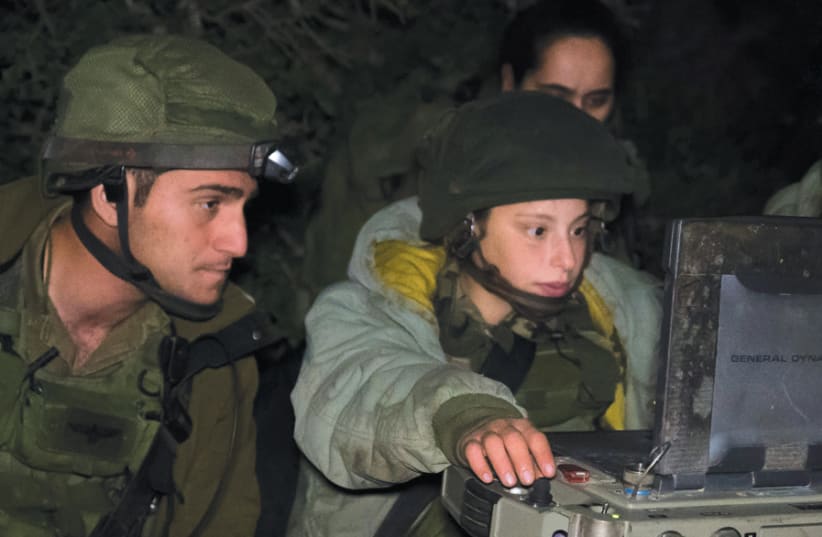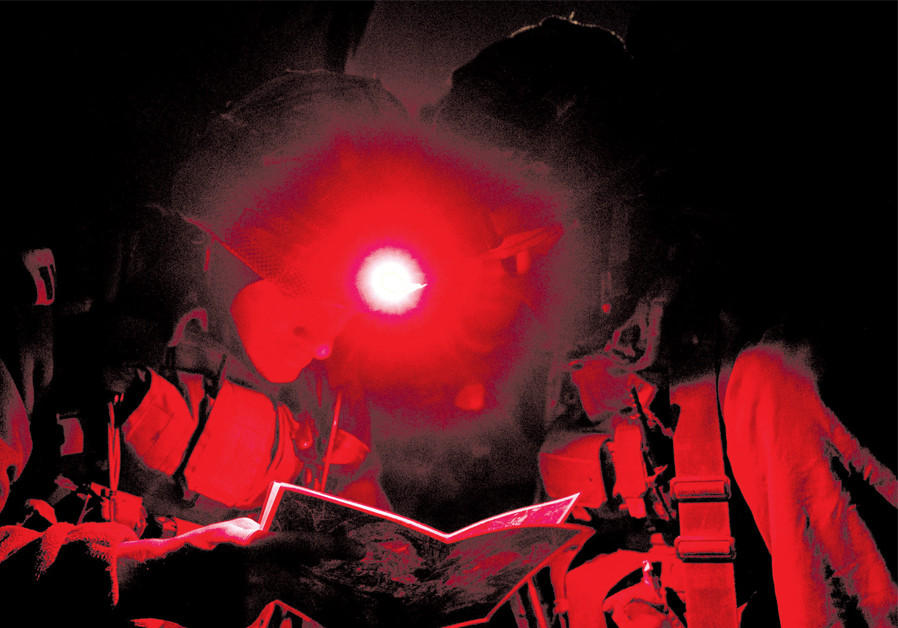ALL OF this technology sounds like a bunch of jargon unless one can see how it works in the field. So I went down at night to join the Skylark unit for a night exercise designed to test the skills of the operators. Parked in the cold, muddy field, three men packed their drone into backpacks that looked more like the kind of size of a pack for carrying a tuba or large musical instrument. It wasn’t clear how the men would get the packs on their back. The IDF officer present said the men needed to practice not only carrying the drone into a rural area but also being able to operate under these difficult conditions of physical stress.Usually four men would carry the drone and its controls. Some of the packs can be up to 50% of the soldier’s body weight. Eventually, with the drone all packed up, the men set off. At least we were walking and could forget about standing still in the cold. The path snaked around the field, through the sodden road hedged by green grass and up a narrow valley between two hills. The road became rutted, the result of torrents of water that must cover it when it rains. It was a full moon and we walked without lights.This elite unit is supposed to be able to carry the drone into an area during operations, which means using night vision during evening hours and walking quietly, preparing for an ambush at any time. Silhoetted against the moonlight, the soldiers with their packs look more like hulking towers than people.This exercise was supposed to test their abilities to navigate in the challenging terrain. This is the kind of hill country one might find in the West Bank or southern Lebanon. At one point, the soldiers got a bit confused, walking up a side road onto the crest of a hill. It was OK with me, I was a bit cold and tired from the walk and happy to look out over the picturesque hills beneath the moonlight. But the pause was momentary: We had gone the wrong way. The men lumbered back down the hill and on to the road again. Up and up through the valley we went. The lights of the town behind us faded.These are same hills where Samson fought the Philistines in the area of Israel called the Shefelah. This is not far from where he took refuge in a case and where he later hacked his enemies to death with the jawbone of a donkey. There were no drones in that era, no technology to prevent armies from blundering into one another in the dark. On our mission, however, things were a bit different. The men are trained not only to carry their drone, but also to be able to fight as combat soldiers at the same time. As we rounded a hill the lumbering soldiers ran into an ambush.“Fire, fire, fire!” the enemy shouted from behind an ancient stone wall. The “enemy” in this case was other IDF soldiers testing the ability of our team to dismount their drone and fight. Advancing against the enemy who were concealed among the rocks, the soldiers dispersed the ambush and made their way back to their packs. Overhead, we could see a small green light. It was a Skylark looking down on us.The drone is designed to operate at day or night, but at night it can fly lower and its quiet motor enables it to conduct surveillance missions without an enemy being alerted. This was clear from our night experience. Only when the drone was a dozen meters overhead could a distant buzzing, like a mosquito, be heard. During the training mission, the drone’s red and green lights are turned on so the trainers can see which way it is going. On the night I went with the IDF there were several drones flying around, like a bizarre light show. In the distance, now that we had surmounted the hill, the lights of Ashkelon and Tel Aviv stood out.Having made it to our objective, the drone operators set about unpacking their packs. Captain Tal Niv showed how the group of operators is divided into three soldiers and their commander.“They have a lot of responsibility,” he notes. Their whole battalion will rely on them to provide this important asset during the mission. The men unpacked the wings of the drone from one pack, the body from another and a command station from another pack. Special lithium batters are also secreted away in a pouch somewhere. Niv explains how the drone needs an open area to be launched. If it has to operate over an urban area it would still need to be catapulted from a field somewhere nearby.The process of catapulting the drone, basically pulling it back on a kind of elastic bungee cord and starting the engine, reminds one of something archaic, like the Wright Brothers’ first flight. You also have to be careful not to have someone in front of you when you launch it. But this enables relatively easy deployment in most conditions.According to the current practice, despite women being integrated into the unit, the female soldier don’t carry the heavy packs and play a slightly different role. At our mountain camp, under the moonlight, one of the women soldiers helped assemble the drone and prepare it for launch. With a wingspan of around 3 meters and a body about 1.5 meters long, the 7.5 kilos of weight makes it difficult to carry too far. The soldier pulled the drone back, further and further until it seemed we’d all fall into the underbrush if we backed up anymore. Then, with a whirring of the engine, the vehicle was off, sailing into the night sky.THE DRONE has received additional technology over the years. This includes improved optics and cameras and other abilities to conduct surveillance, and it now has motorized autonomous flaps. How does it land? It has a kind of airbag underneath that deploys with the sound of small explosion. One would think that the drone must get smashed up landing like this, so it has to be relatively durable. The teams carry some spare parts.As our team’s Skylark buzzed around, the hills were alive with other drones and teams of soldiers carrying out their drills. To see how the soldiers use the drone, we got in the commander’s jeep, finally out of the cold, and drove up the hill a bit more. Hidden under some scrub brush and nestled among the rocks, several soldiers held the control panel and looked on the screen to see what the drone was seeing. The control panel is heavy and resembles a giant table with controls on the side. This appears to be one part of the operation that could be slimmed down during the next round of redesigns.An antenna to communicate with the drone has been set up behind our station and the drone is out there hovering around. Captain Niv explains that the drone can be used to look inside a village to see the threats emerging or keep an eye on potential threats. It could also monitor vehicles on a road, or point out a target for artillery and planes. This versatility means that a squad conducting a raid can be in contact with any threats they face, or it can be used to monitor riots or other adversaries.The three soldiers manning the controls and viewer are the ones who can operate the drone and communicate with others. Down below, the two soldiers who launched the drone are standing near the field, concealed, with their rifles. These drone operators can be deployed to anywhere in the country. They have a jeep ready to go at all times with the UAV and other necessary items, such as food. They can be on site immediately, says the commander.From the northern border to Gaza or the West Bank, Israel’s eye in the sky is watching.
'Post' joins the elite Skylark drone operators for a nighttime exercise
It’s one of those rare cold nights in Israel when you can see your own breath...

It’s one of those rare cold nights in Israel when you can see your own breath. All I want is a ski mask to hide from the air that is creeping around my neck, chilling my face. But I’d neglected to bring one and all I have is a hat and a nice jacket from some Seattle-based outdoors company. Things should be kept in perspective; the soldiers standing next to me are colder.
In February, an IDF unit that uses the Skylark drone was preparing for a nighttime exercise in the hills near Beit Shemesh. It had rained the night before and mud was caked our boots. We were waiting in a field for orders to arrive. A jeep from the commander hummed and three soldiers who are part of the Skylark unit were preparing large backpacks to hike into the hills.
In use for a decade, the IDF Skylark is a versatile unmanned aerial vehicle that can be controlled remotely and can fly autonomously with pre-programmed flight paths. It is used primarily for surveillance and reconnaissance, but has a variety of applications – for example, it can also be used to help in search and rescue. It is considered the IDF’s “standard battalion-level” UAV, according to Elbit Systems, which makes the drone. Weighing 7.5 kg and with a range of some 40 km., it can fly for around three hours and can reach a height of 1,500 feet, according to Elbit.
According to the IDF, it is part of the “effective technology” the army uses, providing precise intelligence in a variety of missions. “As the drones capture images from above, soldiers develop a clear picture of terrorist activity and direct forces to suspects on the ground.”
The drone is one of many Israel uses, but it is unique in having a dedicated unit in the Artillery Corps trained to use it. Initially fielded in 2010, it has grown in its abilities and uses since then. It played a key role in 2014’s Operation Protective Edge in Gaza and also in Brother’s Keeper the same year when it was used alongside Air Force drones. Like most IDF units, it has also integrated women into it missions. It is so easy to use and effective that it has is being used by more than a dozen countries worldwide and has trailblazed new technologies and models.
